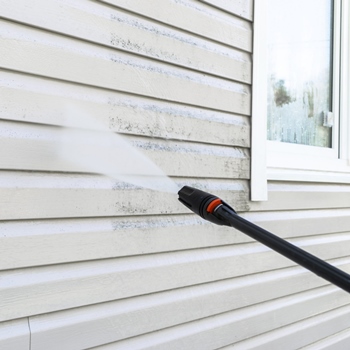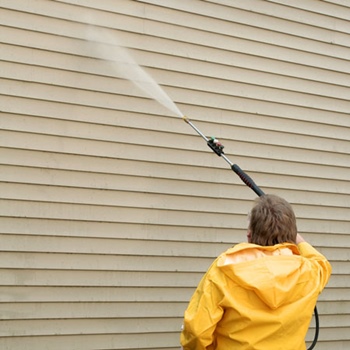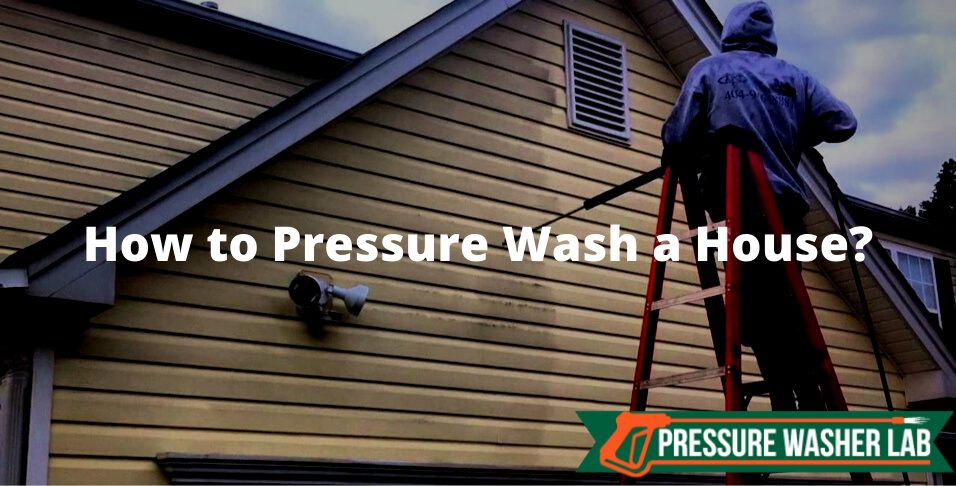To power wash a house, take the following steps:
- Prepare the area before pressure washing a house.
- Set up the pressure washer, adjust the PSI and GPM, and choose the right nozzles.
- Choose the right pressure washer detergent and dilute it before starting in case it is required.
- Rinse the house using a garden hose to remove debris.
- Start from the bottom and move on to the top while pressure washing the house using chemicals to avoid missing a spot.
- Change the nozzles according to the toughness of the surface that is pressure washed.
- Pressure wash the gutters.
- Rinse the chemicals from top to bottom.
- Pressure wash the area around the house and wait until the house walls are fully dry before painting it.
The materials needed to pressure wash a house, the safety precautions, and the steps that need to be taken to safely deep clean a house using a power washer are discussed in detail below.
Materials Needed to Pressure Wash a House
 To pressure wash a house correctly and in a short time, the following materials are required:
To pressure wash a house correctly and in a short time, the following materials are required:
- Pressure washer
- Pressure washer extension wand
- Pressure washer trigger gun
- Pressure washer nozzles
- Pressure washer brush
- Garden hose
- Pressure washer detergent
- Safety goggles
Preparation and Safety Measures
Pressure washing a house is not difficult when the proper tools are used but the area needs to be prepared for cleaning, and some safety measures need to be addressed. The measures recommended before power washing a house are as follows:
- Avoid pressure washing a house made of asbestos, as toxic particles can be released, which can be damaging to the health of the residents. Houses built before 1970 are prone to this problem.
- Avoid pressure washing houses that are covered in lead paint. Buildings that have been last painted before 1978 might have this problem.
- Close any outdoor outlets, as the electrical circuit could get damaged in contact with water.
- Take notice if there are any electric wires around that could get entangled with the pressure washer extension wand.
- If an electric power washer is used, pressure washing the area where the unit’s electric cord is connected to an outlet should be avoided.
- Close all the windows before pressure washing a house.
- Cover or avoid venting areas, as water might get inside the house and create mold.
- Take away all removable objects around the house that might be damaged by water contact, and everything that might cause the operator to treap or entangle the pressure washer cord with.
- Cover air conditioner compressors or generators to avoid damage.
- Cover the vegetation in close proximity to the house before starting the pressure washing task, as some might get damaged due to the use of chemicals.
- Never use a ladder while pressure washing a house, as the power washer’s recoil might cause the user to fall off.
- Always use safety goggles while pressure washing a house.
- Remove any dirt or debris using a garden hose, as they can be removed and propelled at high speeds when pressure washing the surface.
Pressure Washer Set-Up
Set-up
Before connecting the water hose to a water outlet, attach all the accessories to the pressure washer. These accessories include the high-pressure hose, the pressure washer trigger gun, the extension wand, and the nozzle. Using a pressure washer brush to pressure wash a house is optional but it will provide better results. More information on how to set up a power washer can be found in our article ‘How to start a pressure washer?’
PSI
Power washing a house can require different PSI levels, depending on the materials that the house is made of. Houses that have vinyl siding can handle around 2500 PSI but surfaces such as stucco, wood, or aluminum can withstand around 1500 PSI. For the former ones, the use of a gas pressure washer is not recommended, as most of them have minimum pressure rates of around 2000 PSI.
GPM
The water flow rate needed to pressure wash a house is at least 2.3 GPM. The pressure applied can be influenced by choosing the right nozzle and holding it at a recommended distance to avoid damage.
Nozzles
Pressure washing a house with chemicals can only be done by using a soap nozzle, which is the least powerful of all. To power wash a house using clear water, the 0-degree power washer tip is not recommended, as it can damage delicate surfaces because it delivers a narrow spray pattern that is really powerful. The perfect pressure washer nozzle tip for power washing a house is a 25-degree nozzle. The 15-degree nozzle is also suitable if tested on a small area in advance.
Choose the Right Chemicals
Pressure washing a house can be done using plain water but the best results are achieved while using pressure washer detergents. Make sure that the chemicals used are designed for power washer use because the use of improper detergents can cause irreparable damage to the unit. Choose a detergent that is meant for the materials that the house walls are made of. The soaps designed to clean vinyl are different from the ones formulated for concrete.
To powerwash a hose, a mixture of mildewcide solution combined with bleach is often recommended. However, bleach can damage some pressure washer parts, such as the engine and the pump. Using an already-made detergent is more appropriate.
House Pressure Washing Steps
 Step 1. Begin by pressure washing the house walls from the top and continue going down while using clear water.
Step 1. Begin by pressure washing the house walls from the top and continue going down while using clear water.
Step 2. If the house has numerous floors, make sure to change the length of the extension wand every time the distance gets shorter.
Step 3. Perform the cleaning process by moving the wands on a horizontal trajectory, from side to side, and move down to the next section. Make sure to hold the trigger gun with both hands for increased stability.
Step 4. Try to use the right nozzle for different types of surfaces and do not pressure wash fragile areas using a powerful nozzle. When changing the nozzle, ensure to stop the pressure washer, as water pressure applied directly on the body can cause severe damage.
Step 5. When using chemicals to pressure wash a house, begin from the bottom and continue with the upper floors. This order is essential because the cleaning solution will come down when starting from the top and determine the operator to miss various spots.
Step 6. Use a gutter attachment to pressure wash the gutters.
Step 7. Rinse the cleaning solution after changing the pressure washer soap nozzle to a 25-degree one. Hold the nozzle at a 3-foot distance and begin from the top, coming all the way to the bottom. In case the pressure is too high and the surface might get damaged, increase the distance progressively until the right pressure is found.
Step 8. Power wash the area around the house and wait for at least 2 days before performing a paint job on the house.

